WASBE 2009 Conference
Review by Tim Reynish, July 2009
Photos © Kirby Fong
To promote symphonic bands and ensembles as serious and distinctive mediums of musical expression and culture
Il Buono, Il Brutto, Il Cattivo - The Good, The Bad And The Ugly
Great facilities and of course great cameraderie, but Clint Eastwood himself might have had difficulty in making sense of some of the goings-on at the 14th WASBE Conference. If there were any Italian delegates around, I did not meet them, and if Morricone's music was played, I missed it too, but I did hear piece after piece of film music schlock, and my ears were often assaulted by the violence of the bands. This Conference needed a government health warning and ear plugs to be given to each of us.
The superb programme carried a huge amount of information, but not anywhere could I find our WASBE Mission statement, which is why I have put it on the top of the page. Grumpy of Leyland I might be, but WASBE is still sending mixed messages. On the one hand we talk of "SERIOUS AND DISTINCTIVE MEDIUMS OF MUSICAL EXPRESSION AND CULTURE" and on the other the WASBE Artistic Selection Committee accepts programmes which are frankly un-musical and often painful, we put up on our screen in the Members general meeting presentations of the band world in Latvia and Taiwan, marching bands, pom pom girls, poor John Williams imitations vapid folk based pop pap, the lot, and we pat ourselves on the backs for erecting an umbrella which encompasses such a range of national cultures. Come on. Guys, we are meant to be promoting symphonic bands and ensembles as serious and distinctive mediums of musical expression and culture, we have been at it for twenty eight years and its time to ask whether things are better.
Wasbe As An International Organisation
But its fun, people say, its ENTERTAINMENT, and its INTERNATIONA! The great Bobby Adams, regrettably absent, tells his students that they are not in band to have fun, they can have fun 22 hours a day, but band is there to give them an emotional and artistic experience, which might be fun, but which should also run through the whole gamut of emotions. As to being international, we've been through that, oom-pah bands in Schladming, marching band versions of Pictures at an Exhibition in Hamamatsu, sub-Mid West ethnic schlock in Singapore and a mix of all this in Cincinnati. All that said, many thanks to President Glenn Price, and his two closest henchmen, Rodney Winther and Dale Lonis for a very well organised Conference.
Oganisational Hiccups
The facilities were excellent, once you had found your way to the exhibitions and the food outlets but there were basic problems. A "reception" for new WASBE members provided nothing to drink or eat, they were told that they could buy a drink in the lobby. I missed the banquet but gather that it was over-priced and provided a glass of water! The after concert get-to-gethers consisted of having a drink in the lobby with no place to sit and socialize. The bus transfers from the hotels were a disaster - never running at times that people needed; You could either go to the hotel right after a concert or have a drink and wait and hour and a half for the next bus. I am sure that such matters will be superb at the Taiwan conference, and details like this must be considered for each venue.
International Co-Operation
It was good to have involvement by the National Band Association and the Conductors' Guild. Can we hope that the great band organizations of the world might share information on repertoire, courses and conferences more in the future. Can we start by linking up with the JWECC, Japan Wind Ensemble Conductors Conference, perhaps putting a podcast on our website of outstanding new pieces. Their opening concert in March 2009 was a "Concerto Night" with the Nagoya Wind Symphony:
| Work | Composer |
|---|---|
| Duke of Marlborough's Fanfare | Percy Grainger |
| Concertino for flute solo, chamber winds and piano | Jonathan Newman |
| Dontown Diversions for Trombone | Adam Gorb |
| Concerto for Soprano saxophone and Wind Ensemble | John Mackey |
The Good
Below are new or newish works from Conference concerts which I would like to programme if I had a band. I found the repertoire sessions yielded far more programming ideas, and I hope some of those works will be heard in future WASBE Conferences. These are reviewed under Repertoire, but for the conductor at grade 3 or 4, regrettably little repertoire was on show in Cincinnati. Can we stimulate some commissions at this level for Taiwan and Hungary?
| Composer | Work | Duration | Performers | Publishers |
|---|---|---|---|---|
| Abigala | Petit Overture | 3.00 | James Logan Wind Symphony | Composer |
| Alarcon | Concertango for alto saxophone, jazz trio and band | 11.00 | Symphonic Band of Centre Artistic Musical de Betera, Spain | Piles |
| Beurden | Kontrasten | 10.00 | Frysk Fanfare Orkest | Donemus |
| Boutry | Evocation | 16.00 | China Youth Corps Wind Orchestra | Composer |
| Danielpour | Icarus | 11.00 | Keystone Wind Ensemble | Composer |
| Fletcher | Vanity Fair | 5.30 | North Texas Wind Symphony | Boosey & Hawkes |
| Gorb | Metropolis | 14.00 | Royal Northern College of Music | Maecenas |
| Higdon | Percussion Concerto | 25.00 | United States Marine Band | Composer |
| Newman | Symphony No 1 My Hands are a City | 27.00 | James Logan Wind Symphony | OK Feel Good Music |
| Ohguri | Fantasy on Osaka Folk Songs | 12.00 | Philharmonic Winds OSAKAN | Shawnee |
| Pigovat | Winds of Yemen | 18.00 | Symphonic Band of Centre Artistic Musical de Betera, Spain | Piles |
| Pütz | Four Earth Songs | 23.00 | Frysk Fanfare Orkestra | De Haske |
| Pütz | The Jew's Beech | 13.00 | Frysk Fanfare Orkestra | Bronsheim |
| Roxburgh | An Elegy for Ur | 12.30 | Royal Northern College of Music | Maecenas |
| Turrin | Chronicles | 17.00 | Keystone Wind Ensemble | C.Alan |
James Logan Wind Symphony
There are two works from this opening concert on Sunday which I would like particularly to hear again. The first was Petit Overture by a member of the theory staff at New England Conservatory, Juilliard and Boston trained Brett Abigana, an energetic and engaging all-too-brief three minutes. If you enjoy Ticheli's Blue Shades you will probably enjoy this, and I am intrigud to know what his other works are like, Soliloquy for Band written for the Pioneer HS Wind Ensemble, Miserere for large symphonic band, chorus and narrator written for California State University and Suite Fantastique. Its time to commission some more music from Brett Abigana.
Full marks to the James Logan Wind Symphony from California and their very talented conductor, Ramiro Barrera for a great programme and some fine playing, but although I loved much of the Symphony No 1 by Jonathan Newman, I think it needs more mature players to sustain it. I always enjoy Jonathan Newman's music; after the CBDNA 2005 Conference in New York I wrote "Jonathan Newman's The Rivers of Bowery moved with a sure feel for tension and contrast and left me wanting another movement" and after CBDNA 2007 "In contrast we heard Jonathan Newman's beautiful As the Scent of Spring Rain, at last a miniature, full of sentiment but not sentimental". It is difficult to assess fully this Symphony No 1, developed from his New York work, after a dedicated performance but one which found the players often having difficulties with the extended andante or adagio solos and accompaniment. However this is a work well worth hearing again.
It was a great idea to have no less than three school bands playing in the conference, but regrettably on the whole they played college level material, which made a statement about their level of performance but did little to help colleagues develop a repertoire of contemporary school literature.
Symphonic Band Of Centre Artistic Musical De Betera, Spain
At last we had a chance to hear a Spanish band for the first time since WASBE held a Conference in Valencia in 1993. They play with a passion and energy, and one work stood out for me on their programme, Concertango by the conductor of the group, Luis Serrano Alancon. I would recommend this to any band playing Grade 4/5 literature, whether school, college or professional; I have conducted this very successfully on numerous occasions with both players and audience enjoying it thoroghly.
On my website I reviewed a CD called Concertango, and wrote of the piece itself that this is a twenty five minute, three movement concerto for Alto Saxophone, Jazz Trio and Band. Inspired by the music of Piazzolla, the spirit of the Tango is omnipresent, but there are sections which are jazz inspired and wonderfully lazy Mediterranean reflective passages. Two other works on this disc, Memorias de un Hombre de Ciudad or Memoirs of a City Man, and De Tiempo y Quimera, are both major pieces, but it is Marco Polo which for me was a revelation, combining the full Spanish wind band with cellos and basses, with a series of ethnic woodwind and percussion which help to paint the picture of the voyages.
I also enjoyed The Winds of Yemen by Boris Pigovat, with its evocative ethnic music. He has a superb website with details of his music, including the Song of the Sea, premiered in Carnegie hall by Murray State University Wind Ensemble conducted by Dennis Johnson. As I reported in a recent homepage, this work was a great success in its recent German premiere, conducted by Michael Kumnmer, and I have no doubt that The Winds of Yemen will join it as a fine example of this composer's music.
Frysk
It was great to hear music by Bernard van Beurden again at a WASBE Conference, for the first time I believe since Valencia when the delegates heard his Messe. The opening work in this concert was Final Estampie from 1992, an energetic take on the mediaeval dance, and at just over two minutes I guess it is a useful starter for a concert. I remember enjoying the whole piece more as it built up to this exhilarating climax. The second work was Kontrasten, written in 2008, in two contrasting movements, Molto Adagio followed by an Allegro con fuoco. Van Beurden is a serious, thoughtful composer, attempting to break out of the grey commercial mould, and this work is very effective, starting with slow ruminating solos, breaking into an allegro of substance. The harmonic language is contemporary without alienating the audience, his scoring is vivid and the metrical freedom adds considerable excitement, especially in the closing moments. I hope that this appears in a wind band version, as I believe it is worth exploring.
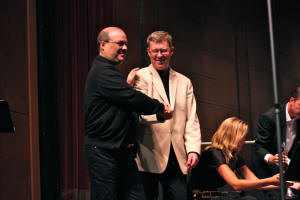
Marco Pütz is a Luxembourg composer who is making a substantial contribution to both Wind Orchestra and Fanfare Orchestra. He has written a number of important concerti, for flute, euphonium, horn, bass trombone and more recently as one of my commissions a fine trumpet concerto, and at least two major tone-poems, Praemonition and Meltdown. There is more information in the composers page of my website; suffice it to say that he is an important voice in contemporary band music, writing what might be termed Gebrauchsmusik but with an honesty and originality of harmonic and melodic writing refreshing in this band business. Four Earth Songs, a song cycle of some twenty three minutes to poems by Graeme King with an often amusing but strongly put Green message, was written in 2008 and premiered here, and proved to be a great success. Again this work will definitely appear in a normal concert band format, which may lighten the colours and change the imbalance that sometimes occurs. The first movement, Tears of Nature, is almost Mahlerian in its intensity, a mood disolved by the high spirited quirkiness of Grrrevolution, a fun piece where not all of the balance problems were successfully solved. Marco, like Adam Gorb, can write slow melodies full of sentiment but not sentimental, and the lyrical diatonic section of this piece is beautiful, whether as the middle section of this ternary movement or in the more fully scored coda, culminating in an excellent envoi.
"When tidal heights rise up and beaches perish,
And there's a lake that once was California,
Perhaps you'll miss what once you used to cherish,
and don't you ever say I didn't warn ya!"
The remaining two movements, a protest song Stand up, and an intense finale Tomorrow, are equally full of passion, ingenious scoring and dramatic interventions, ending with a powerful quotation from the Bach chorale Nun ruhen alle Wälder
As mankind does another tribal dance In hope of something turning in the weather
One enthusiastic delegate asked if you could play this with a smaller ensemble. The scoring which I take to be normal for Fanfare Bands:
- 2 soprano, 2 alto, 2 tenor and baritone saxophone
- 3 flugel horns, four French horns in F, Bb Piccolo and 3 trumpets
- 3 tenor trombones and bass, 2 Bb baritones, 2 Bb euphoniums, 2 Eb bass and 2 Bb bass
- Piano, timpani and 5 percussion players.
I enjoyed Marco's Die Judenbuche, with its horrible story, a tone-poem in ten movements, based on the novel by Annette von Droste-Hülshoff. The basic musical theme is a simple is a simple six note motif, but his scoring is often innovative and the piece is full of big romantic gestures, with some wild and also mournful Klezmer and a fun fugato, and I look forward to the Mark Morette recording arriving to renew acquaintance. If anyone is looking for an easier piece for school band which will lead your players teasingly through a dozen or so keys, buy a copy of Marco's Choralis Tonalis and what a programme for your statement on climate change you could make, pairing the magnificent Praemonitio with Four Earth Songs.
China Youth Corps Wind Orchestra
I really have no idea how good a piece is Evocation by Roger Boutry. It would have made a greater impact if it had not been placed where it was in the programme. My ears were tired, my brain was baffled first by what I considered tastelessness and then by formal incoherence, so Boutry's massive sonorities just added to my misery. Too heavily played here, the piece (I think) demonstrated some great scoring and interesting ideas, but I would need to hear it played with a proper appreciation of dynamics and a feel for a dynamic architecture. It is in four contrasting movements, the third being a nice Ragtime, the fourth introducing more Chinese folk songs.
It was a rare privilege, however, to welcome a Chinese Youth Orchestra, and their conductor Yeh Shu-Han, our host for the next Conference. The Orchestra plays very well, though far too loud for this concert hall. However, there were problems in that the concert they gave had very little to do with either their printed programme which they handed to us nor the programme printed in the Conference schedule. The music they played was often loud and aggressive, sometimes naive to a fault. I found that the dynamic range was a problem throughout the concert; brass and percussion hit anything loud with huge enthusiasm, often with painful results, and much of their repertoire was naive and quite unpleasant. The only lyrical phrases I remember were by Tchaikovsky at the start.
They began with Johann de Meij's Extreme Make-Over; Metamorphoses on a theme by Tchaikovsky which was not on either programme. This might be useful if you want your players to play short excerpts from some of Tchaikovsky's Top Half-Dozen, a sort of Harold Walters Instant Tchaikovsky, strung together with minimalist repetition, but Johann has written far better works than this; I found it tasteless and I wonder how the Artistic Planning committee accepted it - great scoring as always with Johann, but the content made me quite angry, the decibel level hurt even my deaf ear. Again, here was a piece which got very loud and then despite all efforts could not get any louder, despite everyone's most valiant efforts.
After the Tchaikovsky, Yeh Shu-Han told us that the Clarinet Concerto by Chong Yew-Kwang was a very modern piece, which it was on occasion. The concerto began with the soloist skipping around, interrupted by again painfully loud brass and percussion motifs, before settling into what could pass for an English pastoral section, Butterworth or Vaughan Williams at their most ruminative, some nice moments but in the final analysis lacking any personality or coherence; disappointing, despite some persuasive and often virtuosic clarinet playing.
Keystone Wind Ensemble
Jack Stamp was instrumental in commissioning one of the best pieces of the 2005 CBDNA Conference, Richard Danielpour's Voice of the City; I first fell in love with his music when hearing In the Arms of the Beloved on public radio, and I hope that he can be persuaded to continue writing for us. How many of us have tackled Voice of the City, it is a terrific piece, and I am longing to hear the slow movement, at present withdrawn.
Icarus, which was premiered in this concert, is scored for brass and percussion, 5 horns, 6 trumpets, 4 trombones, 2 tubas with a solo trumpet in the audiorium, piano and 7 percussion and is an eleven minute major addition to the brass repertoire. His slow quiet music is especially beautiful, and we need more of that.
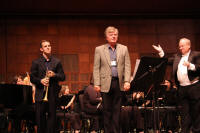
The last work in the first half was Chronicles by Joseph Turrin, a trumpet concerto, written for Philip Smith and the New York Philharmonic and played with effortless brilliance by Tom Hooten of the Atlanta Symphony. Turrin's oevre for wind is significant and his music should be assessed in WASBE publications. Certainly this concerto, with its briliant Prologue,, eloquentLamentation, and virtuoic Epilogue is a great addition to the repertoire. Perhaps WASBE could mount a production of his opera for singers and wind, The Scarecrow, at a future conference.
Their programme was completed by Steven Bryant's Radiant Joy and Jack's own Symphony No 1: In Memoriam David Diamond; I must confess to finding concentration difficult after the Danielpour, and I wondered whether they would have made a bigger impression on me had they been placed after the Schuman. It was good to have Steve around at the Conference, and of course Radiant Joy with its irrepressible high spirits and funky tune - there I go enjoying funk! - is a real crowd-pleaser. Jack's Symphony as I say suffered coming at the end of such an intense concert, but I adored the Romanza, sensitively scored, played and sung by Lauren Jordan. I remember his Four Maryland Songs with great pleasure, but the more energetic movements I would like to hear when coming fresh to them.
University Of North Texas
We are all hugely indebted to Eugene Miraglio Corporon for his amazing recording project, not only of new music in the Klavier series, but also of educational music for GIA and the latestComposer series. He has developed an incredible ensemble at North Texas and their programme was full of brilliant, virtuosic and let it be said, noisy music. It was a great relief to end with Percy Fletcher's Vanity Fair newly edited in the Boosey and Hawkes Windependence series by Brant Karrick and superbly played. Fletcher is reputed to have beaten Holst in the 1909 Composition Competition in London; his writing is exciting and romantic, technically challenging, and delegates were wondering why they had never come across it before, a great addition to the repertoire.
Frank Ticheli's Wild Nights opened the programme and was very good fun, a useful addition to works like Awayday and Masque, good programme openers which can replace Candide. Ecstatic Waters by Steven Bryant I reviewed after enjoying it at the CBDNA conference in Austin. Coming to it a second time, I still enjoyed the sound world although there is a hint of sentimentality about some sections. Four other unfamiliar and relatively new works so that this was more of a repertoire session than a carefully planned concert programme, but throughout another example from North Texas of exemplary playing, superb technical work and great musicianship.
Royal Northern College Of Music Wind Orcestra
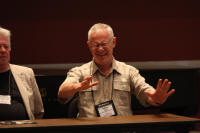
Metropolis is Adam Gorb's first work for wind band, premiered in 1993 at the Royal Academy of Music in London where Adam was a graduate student of Paul Patterson. It won a major prize at the RAM and subsequently the Walter Beeler prize at Ithaca College, but it has never had as many performances as it deserves so it was good for it to have its WASBE premiere. I would have much preferred to hear Adam's most recent work, Farewell, a Mahlerian movement of great stature, with a brief Klezmer interlude before a climax of epic proportions and a final threnody. Metropolis was given a virtuoso performance by the RNCM, as were the other contemporary works in the programme, Edward Gregson's fascinating Metamorphoses with its notable aleatoric techniques and electronics, Michael Oliva's Torso, also with electronic ideas but produced acoustically by bowed crotales, and one of my commissions, David Horne's Waves and Refrains, an incisive work inhabiting the sound world of Lindberg's Gran Duo.
The world premiere on this programme was an extraordinary Double Concerto by Gary Carpenter, wonderfully played by Paul Vowles, clarinet and Melinda Maxwell, oboe. I would have to hear it a few more times to reconcile myself to the Concerto Grosso element that Gary pursued, tutti sections in which the soloists are part of the orchestra, swamped, alternating with solo sections where their melodic invention is thrown into relief. I enjoyed the central slow section as much as anything in the Conference, beautiful lyrical playing from soloists and orchestra. The superb Corbett Auditorium provided an ideal acoustic for this work; back in Manchester, the textures very often seemed to overwhelm the soloists, but in Cincinnati the work fell into sharper focus. I guess I was probably in a minority of one in thinking that six contemporary testosterone filled works in one programme is reminiscent of another band organisation where competition is a major element in conference. However, the playing throughout was exemplary, the conducting by Clark Rundell and Mark Heron incisive and inspiring, but all six works would make a different and bigger impact in a different less noisy setting.
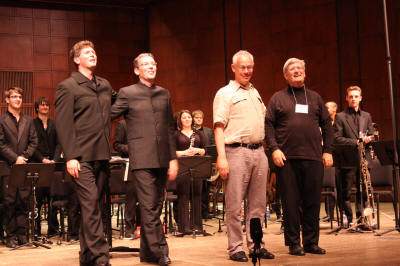
I am biased of course, but another of my commissions, Edwin Roxburgh's haunting An Elegy for Ur, is to my mind a major addition to the small repertoire for oboe and wind ensemble. It is an oboe concerto of great passion lamenting the treatment by the military of one of the oldest cities in the world, Ur of the Chaldees. Beginning as it were with the ghost of the city, a plaintive oboe off-stage, it breaks into four sections, rhapsodies for the oboe interspersed with more rhythmic interludes. It is one of the most poignant works in the repertoire, here magnificently played by Melinda Maxwell who was the soloist in the premiere in 2007, with the Royal Northern College of Music Wind Orchestra. The scoring is for orchestral wind, 2232:4331:3P celeste which should make it possible for our colleagues in the symphony orchestra world. Both Ur and Metropolis can be heard in full performance on the Maecenas website, www.Maecenas.com
United States Marine Band
And so to the finale, the incomparable "President's Own", the US Marine Band under Colonel Michael Colborne. Good programming here, with music from 1840/60, 1909, 1954. 1968 and 2005.
Percussion Concerti
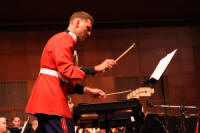
Unfortunately, "The President's Own" misjudged the acoustic of the Cobbett Concert Hall, and some of their performance passed the threshold of pain for me. However, they gave us a fine new work, Jennifer Higdon's Percussion Concerto, with Christopher Rose as the soloist. In her discussion with Michelle Raiker, Jennifer Higdon talked about her approach to the scoring of this particular work, the choice of sticks, the choreography of the performer moving between a myriad of instruments and the variety of sounds available. She adds a further element by involving the percussion of the Band in dialogues with the soloist. Starting with a prelude murmur of marimba, the work is bascially in traditional ternary form, hugely energetic, glittering main thematic material, contrasted with a beautiful central lyrical section featuring bowed mallets, a return to the energy of the start, a coda shared between soloist and orchestral percussion and a final coda. This is a great addition to the repertoire, a worthy companion to the Schwantner transcription which Rose played for us in Luzern with again complete mastery, and three original concerti for percussion and wind orchestra, Thea Musgrave's Journey through a Japanese Landscape, Adam Gorb's Elements, both written for the RNCM and Evelyn Glennie, and the Steven Stucky Concerto, co-commissioned by WASBE but not yet heard at a WASBE Conference. I hope we can programme Higdon's gorgeous Oboe Concerto in Taiwan or Hungary and maybe the Steven Stucky Concerto which we have all helped to pay for.
I am a devotee of that superb arranger for the Marines, Donald Patterson, but I felt that his new transcription of the Shostakovich Festive Overture, while sounding brilliant, encouraged Colonel Colborne to show off the incredible technical talent and virtuosity of his players by going faster and louder than the piece or the hall could take. A lot of detail was lost and the climaxes were as painful as anything else of the week, so we sat back thinking "Wow what amazing players", not "Wow what an exciting piece"; however, this was a bravura performance of the highest calibre, but not very musical. Ive's The Alcotts in the version by Jonathan Elkus, was a welcome reminder of how transcriptions of great music can sound as fresh, spontaneous and original as anything of today. This was beautifully paced by Michelle Rakers, Assistant director.
Wasbe Lifetime Achievement Award
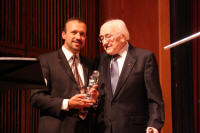
One of the many great new initiatives that President Glenn Price introduced in the past two years is the WASBE Lifetime Achievement Award, with the first recipient Karel Husa, arguably the greatest composer to have written consistently for band over the past half century. It was great to have him with us. The concert in my view should have ended with Music for Prague 1968, here given in as masterful and virtuosic a performance as we are likely to encounter. This is a real work for wind band, an emotional statement of searing intensity, and I do not think that I was alone in thinking that the Sousa encore was totally inappropriate after such a musical experience. As I have said before, Sousa marches are great, following a work such as Lincolnshire Posy, but after Prague, or say the Hindemith Symphony, not for me.
Philharmonic Winds Osakan
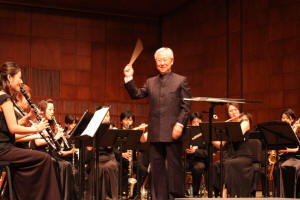
This is a terrific wind orchestra, strong in every section and capable of really refined playing in the right repertoire wih a superb conductor in Yoshihiro Kimura. Their early moring repertoire session was just great. Intriguing programming too, six Japanese works, two conducted by WASBE Presidents, Dennis Johnson and Glenn Price, and two American pieces conducted by the composers. The Japanese certainly know how to score, but I found my notes included the following comments - great film writing - too sentimental - naively constructed with wealth of simple ideas juxtaposed uncomfortably with some tortuous links and modulations - confused textures, what is this piece trying to achieve - brutally loud - good old Richard Strauss - corny Japanese-Americana... I hope every year for an article in the Newsletter or Journal, or a lecture in Conference, to introduce us to the best of the original Japanese repertoire, the repertoire that does not imitate our Amrican colleagues. Can the Artistic Planning Committee achieve this in Taiwan, please? As so often at this conference, my favorite piece was the oldest, Hiroshi Ohguri's Fantasy on Osaka Folk Songs; I have never performed this but my recollection of the original is that it is simpler in its orchestration and more telling than in this version. I may be wrong.
Cincinnati Conservatory Of Music Chamber Players
Unfortunately musical experiences were hard to come by. As always there were some bands playing with culture and finesse, giving musical performances of interesting and sometimes outstanding literature, and as always not enough attention was given to the word Ensemble in our name.
The outstanding musical experience for me was the only chamber concert, given by our hosts. Three works were neatly balanced in this programme drawn from between the world wars, each given an elegance of phrasing and an internal balance rare in other programmes. Of course a chamber group can play loudly in this acoustic without inflicting aural damage, but there are other pressures. The ensemble seemingly has no technical limitations, and while it is invidious to pick out any player from such a superb group, as an old has-been horn player, I was full of admiration for the effortless virtuoso playing of the principal horn. In this repertoire there is no hiding place, and all three works were superbly prepared and played, and given thooughly idiomatic performances, with Martinu and Ibert in real chamber performances with no conductor. The Strauss was gracefully and precisely conducted by our host, Rodney Winther, with a sure sense of line which gave all of the soloists a fine freedom of expression.
| Composer | Work | Year | Publisher |
|---|---|---|---|
| Martinu | La revue de Cuisine | 1927 | Leduc |
| Ibert | Concerto pour Violencello | 1926 | Presser |
| Strauss | Symphony in Eb | 1945 | Boosey & Hawkes |
International Youth Wind Orchestra
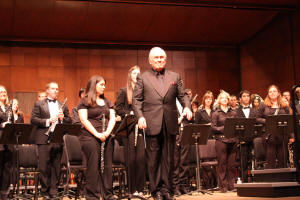
The climax of a week of rehearsals and classes for fifty students from round the world came on the last afternoon, when they were conducted by Frank Battisti, H. Robert Reynolds and Donald Hunsberger in Holst, Graingerand Hindemith. Sessions were open to the delegates, many hours were filmed, and the result will be a record ofdecades of collected experience and wisdom....in these historic compositions. I think that the wind orchestra is a far greater challenge to mould and develop in a short space of time than an orchestra; there is no hiding place, and the collective expertise throughout the group must be at a very high level, whereas an orchestra can hide a few passengers and the better players can carry the weaker players. There is no hiding place in a wind ensemble. The three leaders of our profession got commendable results, perhaps lacking the finesse of articulation and nuance of phrasing which they achieved with their own groups in their pomp, but this was an interesting project well worth putting together. A former student, Simon Tillier, was IYWO Manager and Executive Producer, and he deserves a special mention.
The Bad
I have been a member of WASBE since 1981, and have attended most of the Conferences, missing those in Skien and Valencia; I commissioned Richard Rodney Bennett's Morning Music for Boston and Four Seasons for Manchester, Christian Lindberg's Concerto for Wind Orchestra and Chrisopher Marshall's L'Homme Armé for Sweden, as well as Nigel Clarke's Samurai for Hamamatsu. I was chair of artistic planning for Manchester in 1991 and Sweden and my groups played in Kortrijk, Manchester, Hamamatsu and Cincinnati, so I believe I have a fair overview of how WASBE Conferences have progressed in twentyeight years. I have two major worries, programming and noise level.
Programming
For Manchester and Sweden we invited composers from every Music Information Centre and every publisher to submit compositions to an independant panel who then assessed what should be recommended to the bands which were selected. We sent out scores and where possible CD recordings, gently suggested changes to their proposed programme, tried to get a balance of types of music, of sound worlds, of styles. I remember huge arguements over repertoire with the late great John Paynter, due to bring his Northwestern group to WASBE, Chaltenham Festival and BBC Prom, resolved only when they withdrew because of the Iraq war. I think we must open up our programmes to a wider range of composers, to better composers, we need to be involved in commissioning now for Hungary and for 2015. A composer of any stature needs up to six years to develop a commission, though if he or she has a gap, we may get it for Taiwan, but it is the balance of programmes which is where WASBE must be involved.
We all go to WASBE looking for new repertoire, so premieres are our life-blood, but I think that this conference concentrated too much on the Grade 5 and 6 literature which we hear, let it be whispered, all too often at the CBDNA Conferences, where competition to play louder and faster is often more important than making music. Regrettably there were very few works which any conductor could take home to programme unless he was in charge of a really good group. Maybe after twenty eight years, we could have a retrospective of the greatest new works to emerge, and do more to establish them in the repertoire.
Noise Level
As to the noise factor, I think this is a relatively new phenomenon; very often the bands seemed to be engaged in a kind of Olympic Testosterone competition, which the hall and my ears could often not cope with, and often I wondered whether a work might actually be quite good in a better balanced performance. That all said, it was a great week, but I really do not want to hear another faux naive folk tune, a funky riff nor an overwhelming sonority - well until the next WASBE Conference.
Work after work I did not enjoy; for instance the opening of the Keystone Wind Ensemble concert was Fanfare for the New Millennium which was unfortunately given a performance which for me sums up one of the biggest problems with bands. The thing we do easiest is to make a loud noise, we do not need to work at it, and when we have achieved it it is simply cruel to the audience to go on hoping to make it louder. This is a concert hall, not a football field seating 80,000. Ron Nelson's three minute fanfare is full of glittering colour, swamped here by noise; this was really painful, and of course after about a minute and a half it got no louder despite all the conductor's efforts. Please would all conductors read Gunther Schuller's book, The Compleat Conductor, about dynamics and crescendi, before the next semesterand the next conference.
The Ugly
Our dilemma is encapsulated in the session led by Stephen Budiansky, in which he attacked mercilessly the music education business. Matters got very personal, and debate was never livelier at any WASBE session; I guess probably 80% or more of the audience were on Budiansky's side, but then we emerged into the next concert or two to hear sub-Mid West pieces of such banality that you hoped Budiansky would stand up and issue a polemic against WASBE and the artistic planning commmittee who sanctioned and encouraged the performances. Naturally, if we are going to hear a world premiere, we have little idea of whether it will be a turkey or a swan, but on behalf of those of us who have spent thousands of dollars on airplane tickets, hotel rooms and conference fees, hoping for inspiration and leadership, the planning committee must get it right more often than not, and quite frankly there was a huge discrepency at this conference between the swans and the turkeys.
We were all invited to a reception to launch the next Conference in Taiwan, great food with Sprite or cola, accomapnied by a school band playing..... The WASBE Artistic Planning Committee have a real problem for 2011, not to allow the programming to descend to the depths which it undoubtedly did in Singapore and here in this Taiwan launch.
I am all in favour of band music covering as wide a range of social activities as possible, the marching parade, the circus, the military ceremonial, the folk dance and barbecue, but much of this social activity has nothing to do with WASBE. However, I think that WASBE should be in the business of helping us to discover the best examples and best practice, in school music, community music, university or profssional music. Programming is something they need to give us a lead, so that we don't travel 3,000 miles and spend 3,000 dollars to hear rubbish, and we do not listen to sub-Midwest rubbish just because it comes from Outer Mongolia or Patagonia.
I guess that one of the big drawbacks to the development of the wind ensemble as a serious and distinctive medium is that of taste. Bad taste is endemic in the band world, encouraged through the marching band, the music education programmes, the contesting, all these forums where band music is nothing to do with "art", everything to do with a social or educational occasion. That is fine, and is part of the fun of the umbrella situation, but WASBE must not condone bad taste and perpetuate it in our programming, it must not encourage painfully noisy performances, or sentimental schlock, or if it does programme music which offends, it must be contrasted with performances that do not. How many really musical moments were there in Cincinnati, moments of great artistry which gave some or all of us a goose-bump feeling? How much music from this Conference will delegates take home to perform next year? How far will WASBE's influence develop in the next twenty eight years?
In 1993 Clint Eastwood starred in a film The Perfect World. I guess it will probably take longer than twenty eight years to achieve that, and we may never do so, but we should be trying harder, Any Which Way We Can. Meanwhile its back to the drawing board for another two years. See y'all in Taiwan.